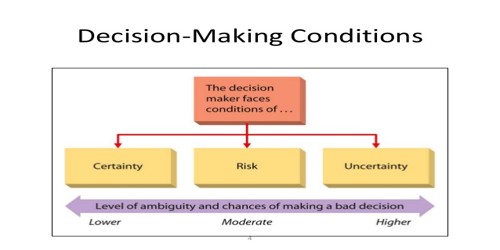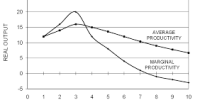Decision Making Conditions
Everyday a manager has to make hundreds of decisions in the organization. There are different conditions in which decisions are made. Managers sometimes have an almost perfect understanding of conditions surrounding a decision, but in other situations they may have little information about those conditions. At the same time, the decision taken by the managers at present will also have an effect on future. For this purpose, the decision-making process involves the visualization of the conditions that may be present in future.
So, the decision maker must know the conditions under which decisions are to be made. Generally, the decision maker makes decision under the condition of certainty, risk and uncertainty. There are three conditions that managers may face as they make decisions. They are (1) Certainty, (2) Risk, and (3) Uncertainty.
Certainty
When the certainty conditions are present, it can be reasonably expected by the managers what is going to happen when a particular decision has been taken by them. Certainty is a condition under which the manager is well informed about possible alternatives and their outcomes. There is only one outcome for each choice. When the outcomes are known and their consequences are certain, the problem of decision is to compute the optimum outcome. Similarly, if there are more than one alternative they are evaluated by conducting cost studies of each alternative and then choosing the one which optimizes the utility of the resources. The condition of certainty exists in case of routine decisions such as allocation of resources for production, payment of wages and salary etc. There is a little ambiguity and relatively low chance of making and impractical decision. In these situations, the managers use a deterministic model, and it is assumed that all the factors are exact and there is no role for chance.
Risk
In a risk situation, although the factual information may be present but it can be insufficient. Mostly the managers have to take business decisions under risk situations. A more decision making condition is a state of risk. In such a condition, managers have knowledge about alternative course of actions but outcomes are associated with probability estimates. It is more difficult to predict future conditions without full information, so the outcome of an alternative cannot be accurately determined. Therefore, managers can guess the probable outcome on the basis of their experience, research and other available information. They can choose an alternative with highest expected outcome. However, such decisions are largely subjective as no decision criteria are fully reliable. Decision making under conditions of risk is accompanied by moderate ambiguity and chances of an impractical decision. On the other hand, the managers may also use subjective probability that is based on their experience and judgment. For this purpose, several tools are available to the managers that can help in taking decisions under risk conditions.
Uncertainty
In case of uncertainty conditions, very little information is available to the managers and the managers are not sure regarding the reliability of such information. A state of uncertainty occurs when managers are unaware of the problem they face. They do not know all the alternatives, the risk associated with them or the likely consequences of each alternative. This uncertainty arises from the complexity and dynamism of contemporary organization and their environments. Managers have limited information to calculate the degree of risk, so statistical analysis is not possible. The condition of uncertainty arises when the organization introduces a new or innovative product or service, adopts new technology, selects new advertising program etc. To make effective decision in uncertain conditions, managers must acquire as much relevant information as possible and approach the situation from a logical and rational perspective. Intuition, judgment and experience always play major roles in the decision making process. However, decision under uncertainty is the most ambiguous for managers and there is more possibility of error. However, there are certain techniques that can be used by the managers for making a better decision under uncertainty conditions. For example, they may use decision trees, risk analysis and preference theory for making the right decisions in uncertainty conditions.
Hence, In conclusion, we can say that greater the amount of reliable information, the more likely the manager will make a good decision. Hence, manager should make sure that the right information is available at the right time.
Information Source;
















